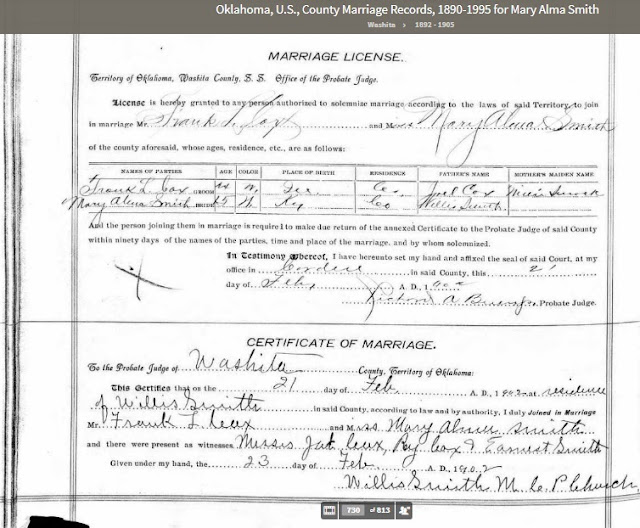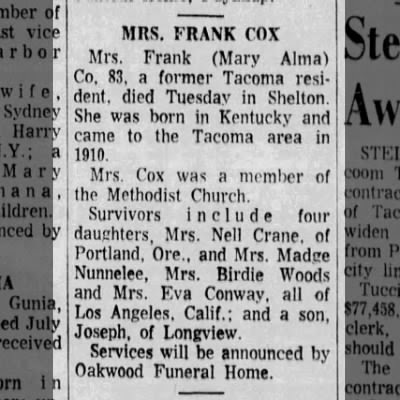Mary Alma’s Teen Marriage: No Elopement Required
Mary Alma Smith: 1886-1969
Usually parents object when their young teenage daughters
are being romanced by older, adult men, but apparently Rev. Willis Smith saw
things differently. Not only did he grant permission for his fifteen-year-old
daughter Mary Alma to marry a twenty-four-year-old man, but he actually
performed the wedding ceremony!
After spending the majority of his life in Kentucky just
miles from Paradise where he was born, Rev. Willis Smith decided, at age 47, to
become a missionary minister in the Oklahoma Territory. He had recently lost
his first wife due to illness, and married Cora Leachman a year later in late
spring 1899. By 1900, he had moved his wife and minor children to El Reno,
Oklahoma, just west of what is now Oklahoma City, and planned to move sixty
miles further west to Arapaho, OK. However, they moved southwest to Washita
County instead.
Mary Alma was Willis’ seventh child, and was only fourteen
when they arrived in Oklahoma. Two of her older sisters, Nancy and Maude, had
already married back in Kentucky, and her three oldest brothers were already
out of the house with families or in college, so Mary Alma and her sister
Stella, age 17, were the oldest of the Smith children in Oklahoma. It must have
been a difficult time for the Smith children, having in the space of one short
year lost their mother, gained a stepmother, and moved away from everyone and
every place they had ever known. Perhaps that explains why Mary Alma and Stella
were searching for love at such a young age.
 |
| Rev. Willis Smith's four daughters--two of them are Mary Alma and Stella, but not sure which two |
Mary Alma and Stella met a pair of young men, first cousins
named Frank Lesley Cox and Roy Stuart Cox. Both were born in Illinois, and had
farmed with their fathers. Frank’s family moved to Elk, Oklahoma by the time of
the 1900 census. Roy, his father and brother were living in Oregon in 1900, but
Roy seems to have relocated to Oklahoma by 1902, as he was one of the witnesses
at his cousin Frank’s wedding.
Frank applied for a marriage license to wed Mary Alma on February
21, 1902. The certificate states that Frank is age 24, and that Mary Alma “is
of the age of 15 years and that the permission of brides parents, which is in
writing and filed in this court, is true and germane.” The court seems to have
taken underage marriage seriously, wanting to ensure that the young woman had
the support of her family.
The wedding occurred at the Smith home the same day the
license was issued. Willis recorded on the marriage certificate that the
witnesses included “Messrs J Cox, Roy Cox, and Earnest Smith.” J Cox was
Frank’s brother Joel, and Earnest Smith was Mary Alma’s older brother who was
visiting from Kentucky.
A quick marriage of an underage girl usually involves an
unplanned pregnancy. However, I cannot confirm that Mary Alma and Frank had a
“shotgun” marriage. I have been unable to find a birth record for their oldest
daughter, Nelle. On various census forms and records, the inferred birthdates
vary between 1902 and 1904. The Family Search family tree shows her birth date
as December 1, 1902, but there is no proof of that date. A December birth date
would indicate Mary Alma got pregnant immediately after the marriage, not
before. So perhaps there was another reason for the hasty, youthful marriage.
Frank and Mary Alma moved frequently during the early years
of their marriage. Their two eldest daughters Nelle and Maude were born in
Oklahoma in 1902 and 1904, and their eldest son Joel was born in Union, New
Mexico in 1906, and their daughter Birdie was born in October 1908 in Texas.
By the time of the 1910 census, the family had moved northwest
to Washington. Frank was working in Prescott, a town in Walla Walla County, as
a well-digger. Their fifth and final child, Eva Blanche Cox, was born June 27,
1912 in Oregon. Mary Alma was only twenty-five, but was the mother of five
children.
By the time of the 1920 census, the family had relocated to
the town of Pomeroy in Garfield County, Washington, and Frank was working as a
farm laborer. The 1930 census found them in Menlo, Washington, where Frank had
found work as a laborer in a lumber camp. Living with them was four-year-old
Vernon Morgus, the son of their daughter Birdie and her ex-husband Vern Morgus,
already divorced after just a few years of marriage.
By the 1940 census, Frank is working as a power line
“bucker” for the WPA—hard work for a 63 year old man. Mary Alma and Frank are
living in Cowlitz, Washington, still raising Birdie’s son who is now 14 years
old, while Birdie has moved to California and is working as a waitress. In
addition, Mary Alma and Frank have taken in Mary Alma’s brother Charlie Smith
and his ten-year-old son David. Charlie states he is farming.
Frank died in 1950, and Mary Alma died August 5, 1969. She
was 83. While Mary Alma was a teen bride, she remained married to Frank her
entire life, and they left five children and several grandchildren. Family was
obviously important to them, as they took on the job of raising their grandson,
and helping other family members. I hope the marriage was as happy as it was
long.














